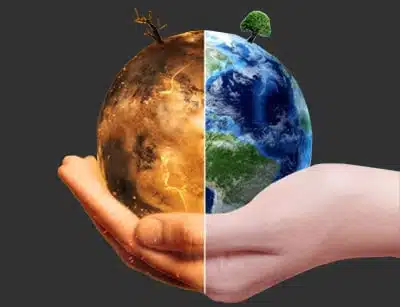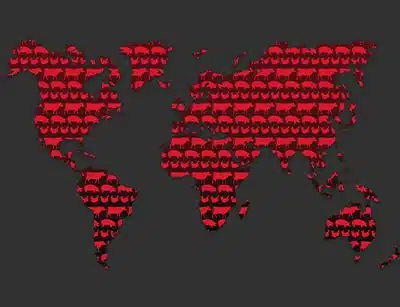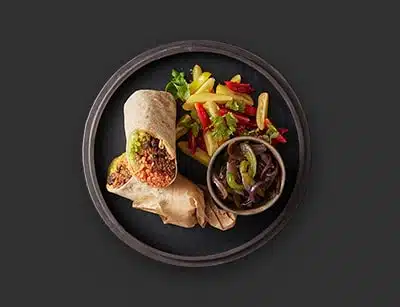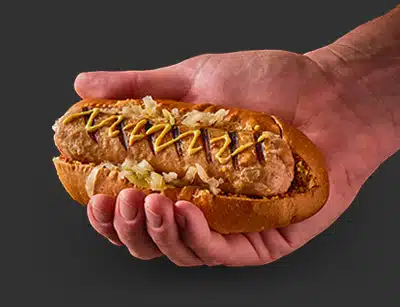
Why is Eating Meat Bad For The Environment?
Let’s start with these huge facts – the global meat industry was estimated to be worth 838.3 billion U.S. dollars in 2020, and is projected to grow to 1157.6 billion U.S. dollars by 2025 according to Statista. Those are some drastic statistics when you consider the relationship between the meat industry and climate change, one of its main negative impacts. If it’s so bad for the environment, why isn’t it showing signs of slowing down?
Keep reading to find out the true environmental impact of eating meat and what you can do to reduce your contribution.

from Statista
Environmental Impact of Meat Production
The world produced around 328 million metric tons of meat in 2020 alone. That’s a lot of animals. The process of producing any amount of meat, even if only small, includes the following:
- Dramatically more land, water and crops are used than alternative protein sources require.
- High amounts of CO2 (carbon dioxide) are emitted that contribute to both air and water pollution – approximately 14.5% of Global Greenhouse Gas emissions come from the meat and dairy industry.
- The meat is often transported around the globe, processed in factories and packed in plastic, then transported again.
That’s not exactly an environmentally-friendly process, is it? So imagine multiplying that by hundreds of millions to match the number of cows that are slaughtered each year.
So we know that the above processes are bad for the environment, especially when conducted on the mass scale required to meet the demands of the current meat industry. We’ve broken down their environmental impact more specifically below.
Deforestation
Land is deforested to make space for both livestock and the crops they eat. Rainforests such as the Amazon are becoming smaller and smaller each year, so much so that the Amazon has reduced in size by nearly 20% since 1970. Considering tropical rainforests act as the earth’s lungs, we’re destroying this vital “organ” that is required for the earth to function.

From Statista, showing monthly deforested area of the Amazon rainforest in Brazil from 01/19 to 06/21
Trees absorb carbon dioxide, convert it into carbon and then store it in their trunks, roots and the soil. Cutting down trees means they’re no longer able to serve their CO2. absorbing function and any stored carbon is released back into the atmosphere. It’s a double whammy for the environment. To turn this into a triple threat, when trees are cleared, they’re often burnt down, which releases even more CO2.
Deforesting trees is not too dissimilar from burning fossil fuels in terms of the negative impact on the environment. In fact, tropical deforestation is responsible for up to 15% of net global carbon emissions every year. This carbon leads to climate change, such as global warming and natural disasters in the forms of droughts, storms, tsunamis and beyond.
Put it this way: that 15% of net global carbon emissions is equivalent to the amount produced by every single car, bus, truck, train, plane and ship on the planet altogether.

Biodiversity Loss
Biodiversity loss also results from deforestation. The trees that are burnt and cut down are home to thousands of species, and so destroying the forests destroys their home. After losing their habitat, these species become extinct (or nearly there). A devastating 50,000 species become extinct every year. This damage is irreversible.

It’s not just species of insects we’re talking about here. Here’s a list of some animals that are currently under threat of extinction:
- The Bornean Orangutan
- The Giant Panda
- The Javan Rhinoceros
- The Mountain Gorilla
- The Golden Lion Tamarin
To save these animals and many more critically endangered species, we must stop destroying their habitats at an alarming rate through deforestation.
Water Usage
Enormous quantities of water are needed for meat production, especially beef. A whopping four times more water is required to produce beef than other forms of protein, e.g. lentils. When you consider that around 72 million tons of beef is produced each year, you can see the magnitude of how much more water we are using where alternative options are available.
Did you know that half of the entire water consumption in the United States goes towards growing grain to feed cattle? Yes, you read that right, half. That’s because beef requires 15,500 liters of water per kilo of end product. Compare that to vegetables, which require a mere 300 liters.
If you’re wondering why this is a problem, take into account that experts predict we are less than twenty years away from running out of freshwater if we do not change our global water consumption habits.

Soil Degradation
In order to raise livestock, you need grazing land. This grazing land can lead to barren land through being overused, and barren land is more susceptible to being blown away. As such, it eventually leads to lost soil. This is concerning because soil is necessary for the absorption of CO2, but the more it’s lost, the more the stored CO2 is released into the atmosphere and the less CO2 can be absorbed going forward.

Sustainability
It’s simply not sustainable to continue eating meat at the rate we currently are. It’s estimated that by 2030, there may only be 10% of the world’s rainforests left. What then? And that’s just one example. As demonstrated above, it’s vital the world does not reach this low point for many different reasons. Now is the time to make the world a more sustainable place.

Meat Industry and Climate Change
Climate change refers to global warming propelled by human-induced greenhouse gas emissions, and the large-scale shifts in weather patterns that occur as a result. Natural disasters such as storms, hurricanes and tsunamis often occur as a result of climate change. It’s also responsible for rising sea levels. Producing livestock is widely believed to be one of the main causes of climate change.
Why is that? Well, it releases greenhouse gases into the atmosphere, including CO2, methane, and nitrous oxide. There are a variety of reasons why this occurs, such as deforestation, soil degradation, the fact that livestock produce methane as they go through the digestive process and from their manure. These are just a few of the many ways.

Other Impacts of Meat Production
Animal Welfare
The meat and animal product industry is growing at such a fast rate, and the demand to keep costs low is ever present. Often, it’s the most unethical farming practices that cost the consumer the least. These include caging animals, feeding them additional hormones, and numerous other methods that infringe on their welfare and compromise their health. This doesn’t stop the popularity of low cost animal products, though.

Health Risks
It’s common knowledge that red meat, processed meat and high-fat dairy products are not the healthiest options out there, especially when consumed in high quantities. They’re linked to a higher likelihood of developing cardiovascular disease, diabetes, and more. On the flip side, fruit, vegetables and fiber can help reduce the risk of the very same diseases.
We are not unaware of the importance culture, socio-economic factors and location play in our choices to consume the animal products we do. But we do know that there are many more alternatives now than even just a decade ago, and far more education to coincide.
Environmental Benefits of Vegetarianism
We’ve outlined the environmental issues caused by meat production above. The obvious way to reduce the environmental impacts and climate change is to reduce our meat consumption, so the industry will then produce less meat altogether. This doesn’t have to mean a strictly or vegetarian diet, but that can certainly help.
However, this isn’t necessarily a perfect solution. As humans, we still need lots of protein to fulfill our diets, and oftentimes we need easy and obvious protein sources. After centuries of meat-eating, we can’t just expect the desire for meat and our eating habits to change overnight. No matter whether the environment hinges upon it or not. That’s why New-Meat™ alternatives are necessary to aid the transition.
Should I Stop Eating Meat?
Nobody can answer this question for you definitively. It’s not a “yes” or “no” question. Instead, you need to arm yourself with all the facts and come to your own conclusion based on your lifestyle and values.
Whatever you decide, it is recommended to reduce your meat consumption for the benefit of the planet. The responsibility falls on governments to introduce policy changes to encourage this to happen, as much as it falls on individuals.
What is an Environmentally Friendly Diet?
While this differs according to your source, the World Health Organization (WHO) recommends a sustainable diet include:
- Whole grains, legumes, nuts and an abundance and variety of fruits and vegetables
- Optional: moderate amounts of eggs, dairy, poultry and fish, and small amounts of red meat
- Minimized antibiotic use and hormones in food production
- Minimized plastics and derivatives in food packaging
- Reduced food loss and waste
If you’re wondering what quantifies “small amounts of red meat”, it’s generally considered to be either one beef burger a week or one large steak a month.
Alternatives to Meat
Plant-Based Proteins
This includes a wide variety of food, many of which you might consume without even realizing they’re a protein source, like quinoa for example.
- Quinoa
- Soy
- Pulses: lentils, chickpeas, peas, beans, etc.
- Nuts and seeds
- Seitan
- Oats
- Vegetables: broccoli, avocado, kale, spinach, cauliflower, etc.
New-Meat™ – REDEFINE MEAT™
If you’re looking to reduce your meat consumption but not sure how New-Meat™* could be the perfect option for you. It’s an easy solution that doesn’t require thinking outside the box (on your behalf, at least). You can eat all your favorite meals without having to make any compromises. REDEFINE MEAT™ products are just like the meat you know and love, but better. You can enjoy ground beef, flanks, burgers, kebabs, sausages and more – precisely the same, entirely different.
*New-Meat™ does not contain animal-based ingredients
Don’t stress about building a whole new repertoire of recipes. Your vegetarian meals don’t have to be meat-free, the meat is simply redefined – it’s New-Meat™. Feeling a Spaghetti Bolognese? No problem. In the mood for a burrito? That works too.

REDEFINE MEAT™ products have been created in association with world-leading chefs, butchers, and meat experts to deliver the best experience for even the most keen meat lovers out there. Meat industry climate change is a real issue, but you can lessen your contribution while still enjoying a meat experience.
FAQs
Is eating meat bad for the environment?
Meat production contributes to climate change for many reasons. Agriculture is one of the leading causes of deforestation, which is responsible for around 15% of Global Greenhouse Gas emissions. As a result of deforestation, 50,000 species become extinct every year. Livestock require immense volumes of water, their grazing land leads to barren soil, and that’s not even mentioning the amount of methane released into the atmosphere from their manure!
Why is meat bad for the environment?
As mentioned above, meat production contributes to climate change, is a driving force behind deforestation, biodiversity loss, water overuse and infertile soil, to name just a few reasons it’s bad for the environment.
How does not eating meat help the environment?
Taking into account the negative environmental impact of eating meat, reducing your consumption or cutting it out entirely is one less contribution to a harmful industry. With each less contribution, the industry becomes smaller and we’re one step closer to saving the planet from global warming and beyond.
What would happen if everyone ate less meat?
The problem with the meat industry is not necessarily the consumption of meat itself, but the mass industrialization of it. So, if everyone reduced their intake, there would be less deforestation, less CO2 emissions, less water overuse, etc. We could help reverse the effects of global warming before it’s too late.




